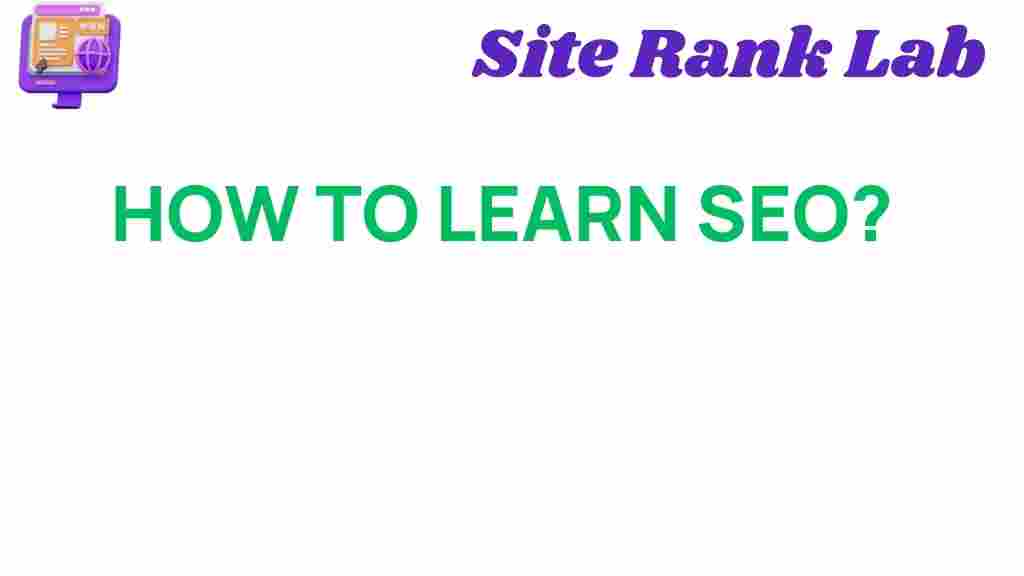How to Learn SEO
Search Engine Optimization (SEO) is no longer optional in today’s competitive digital landscape. Businesses, bloggers, and entrepreneurs alike must learn how to use SEO effectively to improve their visibility, attract their target audience, and drive meaningful engagement. But where do you start? This guide will help you master the essentials of SEO, offering clear steps, expert tips, and troubleshooting solutions.
What Is SEO and Why Is It Important?
SEO is the practice of optimizing your website so it ranks higher in search engine results pages (SERPs). Higher rankings mean greater visibility and an increased likelihood of attracting organic traffic. Whether you run a small blog or a large e-commerce platform, SEO can transform your online presence, driving higher traffic, boosting credibility, and even improving conversion rates.
Step 1: Understand the Basics of SEO
Before diving into advanced techniques, familiarize yourself with the basic principles:
- Keywords: Identify the terms your audience searches for and strategically place them in your content.
- On-Page SEO: This includes optimizing titles, meta descriptions, headers, and images.
- Technical SEO: Ensure your website loads quickly, is mobile-friendly, and has a clean URL structure.
- Off-Page SEO: Build high-quality backlinks and establish your website’s authority.
For a deeper understanding of these concepts, you can explore this detailed beginner’s guide to SEO.
Step 2: Choose the Right SEO Tools
SEO success depends on the tools you use. Here are some must-have tools for every SEO enthusiast:
- Google Analytics: Monitor your traffic and identify user behavior patterns.
- Google Search Console: Gain insights into how Google views your site and fix issues.
- Ahrefs or SEMrush: Conduct keyword research, analyze competitors, and track your progress.
- Yoast SEO: Perfect for optimizing WordPress content.
For internal linking strategies, visit our resource on boosting on-page SEO.
Step 3: Conduct Comprehensive Keyword Research
Keywords are the backbone of SEO. To identify the best keywords:
- Use tools like Google Keyword Planner or Ubersuggest to find relevant terms.
- Analyze search intent to understand whether users seek information, products, or services.
- Focus on long-tail keywords to target niche audiences with lower competition.
Always balance volume with intent—ranking for high-volume keywords won’t matter if they don’t drive conversions.
Step 4: Create High-Quality, Optimized Content
Content is king in the world of SEO. Here’s how to create content that ranks:
- Write for your audience first, but optimize for search engines.
- Incorporate keywords naturally into your headings, subheadings, and body text.
- Use engaging visuals, such as images, infographics, and videos, to increase dwell time.
- Ensure your content answers common questions or solves a problem.
Remember, consistency is key. Publish new content regularly to keep your site fresh and relevant.
Step 5: Optimize On-Page SEO
On-page SEO refers to optimizing individual pages for targeted keywords. Key elements include:
- Title Tags: Keep them concise, relevant, and under 60 characters.
- Meta Descriptions: Summarize your content enticingly in 155 characters or fewer.
- Internal Linking: Link to other relevant pages within your site to improve navigation.
- Image Optimization: Use descriptive alt text and compress images for faster load times.
Step 6: Build High-Quality Backlinks
Backlinks, or inbound links, are crucial for off-page SEO. To earn quality backlinks:
- Collaborate with reputable blogs or websites in your industry.
- Create shareable resources, such as ebooks or infographics.
- Use outreach emails to pitch guest posts or content partnerships.
- Participate in relevant forums and communities to build credibility.
Quality matters more than quantity. A few authoritative backlinks can significantly boost your rankings.
Step 7: Measure, Analyze, and Adjust
SEO isn’t a one-time task. Regularly track your performance and make adjustments as needed:
- Track Rankings: Monitor how your targeted keywords are performing.
- Analyze Traffic: Use tools like Google Analytics to identify trends.
- Fix Errors: Regularly audit your site for broken links, missing meta tags, or slow-loading pages.
Stay up-to-date with algorithm changes and industry trends to keep your strategy relevant.
Troubleshooting Common SEO Issues
Even the best strategies encounter obstacles. Here are some common problems and their solutions:
- Low Rankings: Revisit your keyword strategy and optimize underperforming pages.
- Slow Website Speed: Compress images, leverage browser caching, and use a Content Delivery Network (CDN).
- High Bounce Rate: Improve your site’s design, ensure mobile responsiveness, and write compelling content.
- Duplicate Content: Use canonical tags or 301 redirects to avoid penalization.
Conclusion
Mastering SEO is an ongoing journey, but with persistence, the right tools, and effective strategies, you can elevate your online presence significantly. By understanding SEO basics, leveraging powerful tools, and continuously optimizing your content, you can ensure long-term success in the digital space.
Start applying these SEO strategies today, and don’t forget to explore our comprehensive SEO resources for additional insights. Happy optimizing!
This article is in the category SEO and created by SiteRankLab Team
